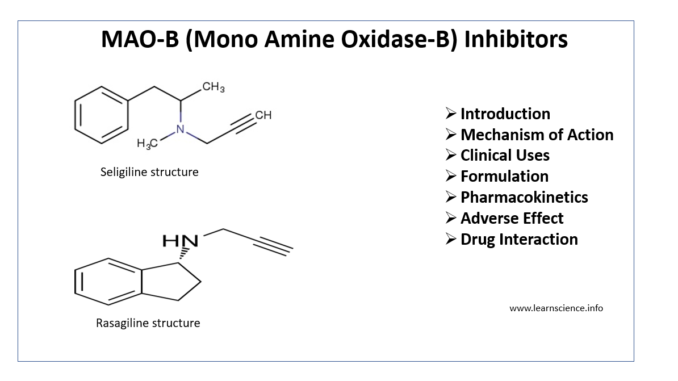
- MAO-B (Mono Amine Oxidase-B) inhibitors are class of medications used to treat symptoms of Parkinson’s disease. They are earliest drugs tried in Parkinson’s disease (PD). They are used with or without levodopa.
- Though levodopa- carbidopa therapy is considered gold standard treatment for PD, chronic treatment is associated with motor complications, ‘wear-off’ effect and random switches between ‘on’ and ‘off’ effects. So, additional medicines are prescribed to manage symptoms of PD. MAO-B inhibitor is one such example of medicine.
- Some example of approved MAO-B inhibitors for treating PD symptoms are selegiline, rasagiline and safinamide.
- Selegiline is 1st selective MAO-B inhibitor synthesized in 1965 by Knoll and Magyar. Rasagiline is chemically related to selegiline and is second-generation selective MAO-B inhibitor. Safinamide is approved by FDA in 2017 for Parkinson’s patients taking levodopa/carvidopa during ‘off’ episodes.
Mechanism of action of MAO-B inhibitors

- Parkinson’s disease is related to reduced amount of dopamine in specific parts of brain.
- MAO is an enzyme distributed all over the cells in body. There are two types of MAO enzyme. MAO-A is responsible for oxidative deamination of tyramine, nor-adrenaline (NA) and serotonin (5-HT). MAO-B is responsible for chemical breakdown of dopamine in brain.
- MAO-B inhibitors inhibit the activity of this enzyme and reduce the breakdown of dopamine resulting in increased concentration and storage of dopamine in striatum.
- Thus, it helps to prolong the duration of improvement brought by levodopa.
- Selegiline is selective, irreversible inhibitor of MAO-B. It can inhibit MAO-A if administered in higher doses (>10 mg). Rasagiline is more potent and selective than selegiline. Safinamide possess anti-glutamatergic effects and also acts as MAO-B inhibitor.
Clinical Uses of MAO-B inhibitors
- Both selegiline and rasagiline are useful in treating motor symptoms in PD as monotherapy and in combination with L-DOPA and decarboxylase inhibitor. Rasagiline is more effective in this regard. It is five times more potent than selegiline.
- They can be used alone in early stages of PD and delay the need of levodopa.
- Safinamide is used as add-on treatment during off episodes of PD. In off-episodes, effect of levodopa can wear off for some time. Safinamide is not effective as monotherapy.
Formulations
- Different formulations of MAO-B inhibitors are:
- Eldepryl (selegiline hydrochloride)
- Carbex (selegiline)
- Zelapar (selegiline hydrochloride, orally disintegrating tablet)
- Azilect (rasagiline)
- Xadago (safinamide, tablets)
- Emsam (selegiline patch)
Pharmacokinetics of MAO-B inhibitors
- Both rasagiline and selegiline are fast absorbed after oral administration and maximum concentration is seen within 1 hour.
- Selegiline is extensively metabolized by hepatic cytochrome P450 2A6, 2B6, and 3A4 with production of derivatives like methamphetamine mainly and L-amphetamine and desmethylseligiline in smaller quantity. Desmethylseligine also possess MAO-B inhibiting activity. Amphetamine and methamphetamine may cause anxiety and insomnia. When taken with food, its bioavailability increases 3-4 folds.
- Absolute bioavailability of rasagiline is about 36 %. Inhibition of MAO-B in platelet last for up to or more than 1 weeks after last oral dosing. It is extensively metabolized by CYP isoenzymes by dealkylation and hydroxylation and metabolite are aminoindan. It is excreted in urine (mainly), smaller quantity in feces and as unchanged form in urine.
- Safinamide is absorbed well through GI tract and maximum concentration is observed within 2-4 hours. It is metabolized by amide hydrolytic oxidation to safinamide acid. It is excreted through urine as inactive metabolites.
Adverse effects
- The common side effects include headache, nausea, hallucination, dyskinesia and dizziness. Seligiline may cause insomnia and anxiety. Rasagiline may cause joint pain, orthostatic hypotension and indigestion. Safinamide may cause orthostatic hypotension, cough, dyspepsia.
- Other possible side effects include dry mouth, constipation, an urgent need to pass urine and flu-like symptoms.
Drug- Interactions
- They may cause serious side effects when taking with other drugs like antidepressants, selective serotonin reuptake inhibitors (SSRIs), tricyclic antidepressants and serotonin- norepinephrine reuptake inhibitors. They should be discontinued for some time before starting antidepressants.
- When consumed with food containing higher amount of tyramine (more than 150 mg), there is risk of raising blood pressure to dangerous level.
- Patients should discuss about their regular diet and other medications with their doctors before starting MAO-B therapy.
References
- https://www.drugs.com/pro/selegiline.html
- https://www.drugs.com/monograph/safinamide-mesylate.html
- https://www.drugs.com/monograph/rasagiline-mesylate.html
- Binde CD, Tvete IF, Gasemyr J, Natvig B, Kelmp M. A multiple treatment comparison meta‐analysis of monoamine oxidase type B inhibitors for Parkinson’s disease. Br J Clin Pharmacol. 2018; 84(9): 1917-1927.
- Finberg JMP. Pharmacology of Rasagiline, a New MAO-B Inhibitor Drug for the Treatment of Parkinson’s Disease with Neuroprotective Potential. Rambam Maimonides Med J. 2010 Jul; 1(1): e0003.
- Muller T, Mohr J. Pharmacokinetics of monoamine oxidase B inhibitors in Parkinson’s disease: current status. Expert Opinion on Drug Metabolism & Toxicology. 2019; 15(5): 429-235.